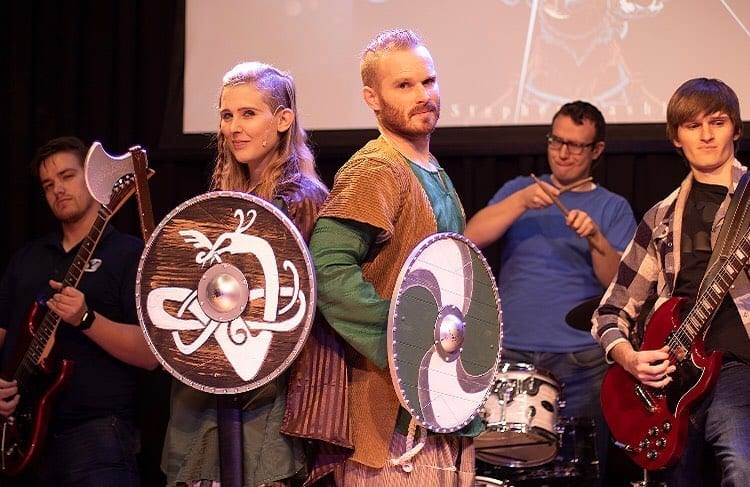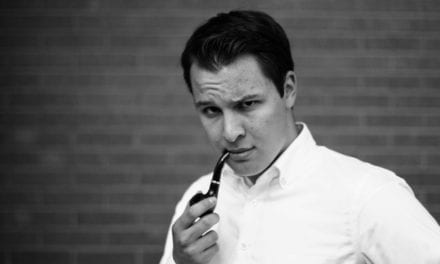SPANISH FORK — The new Angelus Theatre in downtown Spanish Fork holds on to its history as a century-old motion picture theater, complete with chandeliers and vintage pianos and with upgrades fit for 2019. With its reestablishment as a theater and events venue, the top-of-the-line sound systems were prepared to present a spectacular show.

Show closes November 18, 2019.
Valhalla! A Nordic Rock Opera, produced by Avonlea Theater Company, was this spectacular show. Valhalla is a new, original musical that began as a lifelong dream and then successful Kickstarter campaign of Stephen Gashler—who wrote, produced, and starred in the play’s first full production in Spanish Fork. The story line follows a group of ages-old vikings who sought the traditional life of pillaging and plundering, but when one Norwegian man gets mixed in with a Saxon nun, a story of self-discovery begins.
In what may be an attempt at creating a fictional origin story for the arrival of Christianity in Scandinavia, transitioning from the barbaric rule of the vikings, there seems only one word to describe Stephen Gashler’s story: fun. There were, however, times when the plot became slightly confusing. How did Sven and the nun get separated from the rest of the vikings? When they arrived in Norway, how could Sven not recognize his own village, if it was his village? Because performers were, out of necessity, reused in various roles, were the dancing dead people actually his family and friends, or some other group of vikings who had passed on? This reuse of actors and actresses added to the confusion on other occasions, but if there are future, larger productions of Valhalla, I do believe these moments would be made more clear.
The music and lyrics, also by Stephen Gashler (with additional music and lyrics by Desire Gashler, Teresa Gashler, and Monte Emerson), were catchy and upbeat, varying in genre and form, and they complemented the entertaining story line. Accompanied by both pre-recorded music (created in part by audio engineer Joe Cassler) and a live band that kept itself at the back of the stage (with Taylor Adam on the guitar and Cassler on the drums), the music was a sensational mix of folk, rock, gospel, and even indigenous melodies. Remarkably enough, the soundtrack has already been recorded as an album and is available in CD form and to stream digitally.
Director Matthew Davis and Assistant Director Stephanie Featherstone used the Angelus Theatre’s space well. On many occasions, actors and actresses came out into the aisles of the audience as part of particular scenes, and when onstage, the blocking was well-done and visually appealing. Set changes, even when they were minimal, were well-rehearsed and never distracting. All in all, I was quite impressed by the quality of this production put on by a community theatre under the direction of Davis and Featherstone.
Valhalla’s choreography, choreographed by Bethany Taylor, was fairly simple but appropriate for the wide range in ages and experience of the local cast. With a few exceptions of more intricate moves, such as in the maiden warrior’s number at the end of the first act, the majority of dances were unsophisticated but fun. I did see the performers move in circles over and over again, which felt dull and unimaginative. That being said, other moves—from air guitaring to hand gestures and even dabbing—were relevant and connected. Taylor’s choreography was nothing incredible, but it was befitting of this specific production.
Costume designer Rhonda Seiter did terrific work bringing to life the collision of “barbaric” vikings and “civilized” Saxons, juxtaposing the pagan beliefs of Norse mythology with Christianity. The vikings, aside from Sven and Magnhild, wore muted, neutral tones that seemed appropriate for their primitive lifestyles, with loosely draped robes and belts at their waists to carry their weaponry. The Saxons (such as Sir Hector) wore bright colored clothes that symbolized their wealth and civilization, suitable for the time period being portrayed.
It is also notable that Seiter created golden, shimmering elements for the costumes belonging to the Norse gods (Thor and Odin), placing them at a level above the rest. Even the nuns were costumed in full nun’s habits and rosaries. No detail was left unnoticed (aside from the nun’s wedding ring, which just made my wife and I chuckle), from the color coordination to the jewelry choices. Great work, Seiter.
The set design, directed by Set and Technical Director Sarah Bobby Hinckley, was also simple but perfect for Valhalla. The only backdrop was a relatively small projector screen, which was well-used with non-distracting videos or still images with moving overlays. From mountainous landscapes to Norwegian stabburs, the projections were interesting and helped the audience to know where scenes were taking place while not diverting attention from the performance in any way. Importantly, they were not an excuse for a lack of a physical backdrop.
Aside from this, Hinckley’s stage was mostly blacked out, and assorted furniture pieces and large-scale props, such as tables and benches, gravestones, and even a ship’s mast and sail, were moved in and out to help fill the space and provide context for the plot. Hinckley’s set direction was uninvolved yet complete.
Though there were not props or set pieces for every moment, the actors and actresses compensated by miming actions that clued the audience in as to what they were using—from doorways to a helm to the edges of a ship. There were several talented performers in Valhalla, but I will just name two of the stars here.
Sven was played by Stephen Gashler, the creator of Valhalla. Stephen Gashler had a strong voice that harmonized incredibly well with the actress who played Mary. Stephen Gashler as Sven often stood stoic, looking past the audience as though he saw some great, panoramic view that he wished to conquer; later in the production, though, Sven seemed more gentle, holding Mary and sincerely explaining to the other vikings that peace may be more important than the treasure of plunder. Stephen Gashler was committed to his role and convincingly portrayed a viking leader of sorts while also showing the change of heart that his character experienced through the ups and downs of the story line.
Maren Hansen played Mary the nun, and Hansen was the star in this performance. Her ability to hit any note she was given and to harmonize in an angelic, almost operatic voice with the grunge-rock anthems sung by the vikings was absolutely impressive. Hansen’s facial expressions and body language also made her character feel real, and I was convinced the whole way through that Mary was a nun who had nearly fallen in love. Hansen was undaunted by the unique role she was assigned, making it difficult for me to imagine any other actress portraying her character.
As a final word, Valhalla! A Nordic Rock Opera has great potential. Though in its current form, I do not anticipate seeing it on Broadway anytime soon, the Spanish Fork community did a spectacular job of bringing to life Stephen Gashler’s original, musical production. Valhalla would be well worth your family’s time and money to see while it runs at the historic Angelus Theatre.




